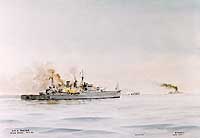
At dawn on 13 December 1939 the German armored ship (or "pocket battleship") Admiral Graf Spee, cruising toward South America's Rio de la Plata (River Plate) in search of enemy merchantmen, sighted distant masts. She had been operating in the south Atlantic and Indian Oceans for three months on a successful campaign to disrupt allied shipping and tie up British and French Naval forces. Twenty-three major warships were actively hunting for her. Now the two sides were about to meet, for those masts belonged to three British cruisers, Exeter, Ajax and Achilles (the latter part of the Royal New Zealand Navy). Initially thinking these were merchant vessels, Admiral Graf Spee's Captain Hans Langsdorf headed for them, continuing his approach once their true nature was known.
British Commodore Henry Harwood, on board Ajax, also steamed toward his enemy. The opposing ships closed rapidly to gunfire range, with shooting beginning at just under 20,000 yards. Harwood divided his force, complicating Langsdorf's gunnery, but both sides began hitting early. Exeter was very seriously damaged by the German's eleven-inch guns: both of her forward eight-inch gun turrets were knocked out, her bridge crew was largely killed or wounded and fires raged amidships. She gamely remained in action until her remaining turret would no longer function. Admiral Graf Spee had also been repeatedly struck by Exeter's shells, and by six-inch projectiles from the other two cruisers. She laid a smoke screen and turned away, firing on Ajax and Achilles, and disabled two of the former's gun turrets.
An hour and twenty minutes of intense combat was followed by a long day's pursuit as Admiral Graf Spee headed for Montevideo, Uruguay, harried by Ajax and Achilles. She arrived just after midnight on 14 December and requested time to make repairs, reporting to the Uruguayans that she had been hit some seventy times. The British decided to keep the German warship in port as long as possible so they could bring up reinforcements. To this end they resorted to diplomatic trickery and broadcast misleading reports that the carrier Ark Royal and battle cruiser Renown were nearby. Captain Langsdorf, with much of his ammunition expended and his ship damaged, was soon persuaded that escape was impossible. After consulting with the German Government, in the early evening of 17 December he took his ship out into the broad river and blew her up, completely demolishing Admiral Graf Spee's after portion and leaving her a sunken, burned-out wreck.
Her crew went to Argentina where, on the night of 19-20 December 1939, Captain Langsdorf took his own life. The Battle of the River Plate, first of World War II's many great sea battles, greatly boosted British prestige and morale, but at considerable cost. The badly injured Exeter, initially thought not worth repairing, was out of the war for fifteen months. Repairs to Ajax lasted until mid-1940.
This page features, and provides links to, all the views we have concerning the December 1939 Battle of the River Plate.
For more images related to this action, see:
| If you want higher resolution reproductions than the Online Library's digital images, see: "How to Obtain Photographic Reproductions." |
Click on the small photograph to prompt a larger view of the same image.
For more images related to this action, see:
| If you want higher resolution reproductions than the Online Library's digital images, see: "How to Obtain Photographic Reproductions." |
Page made 8 October 2006